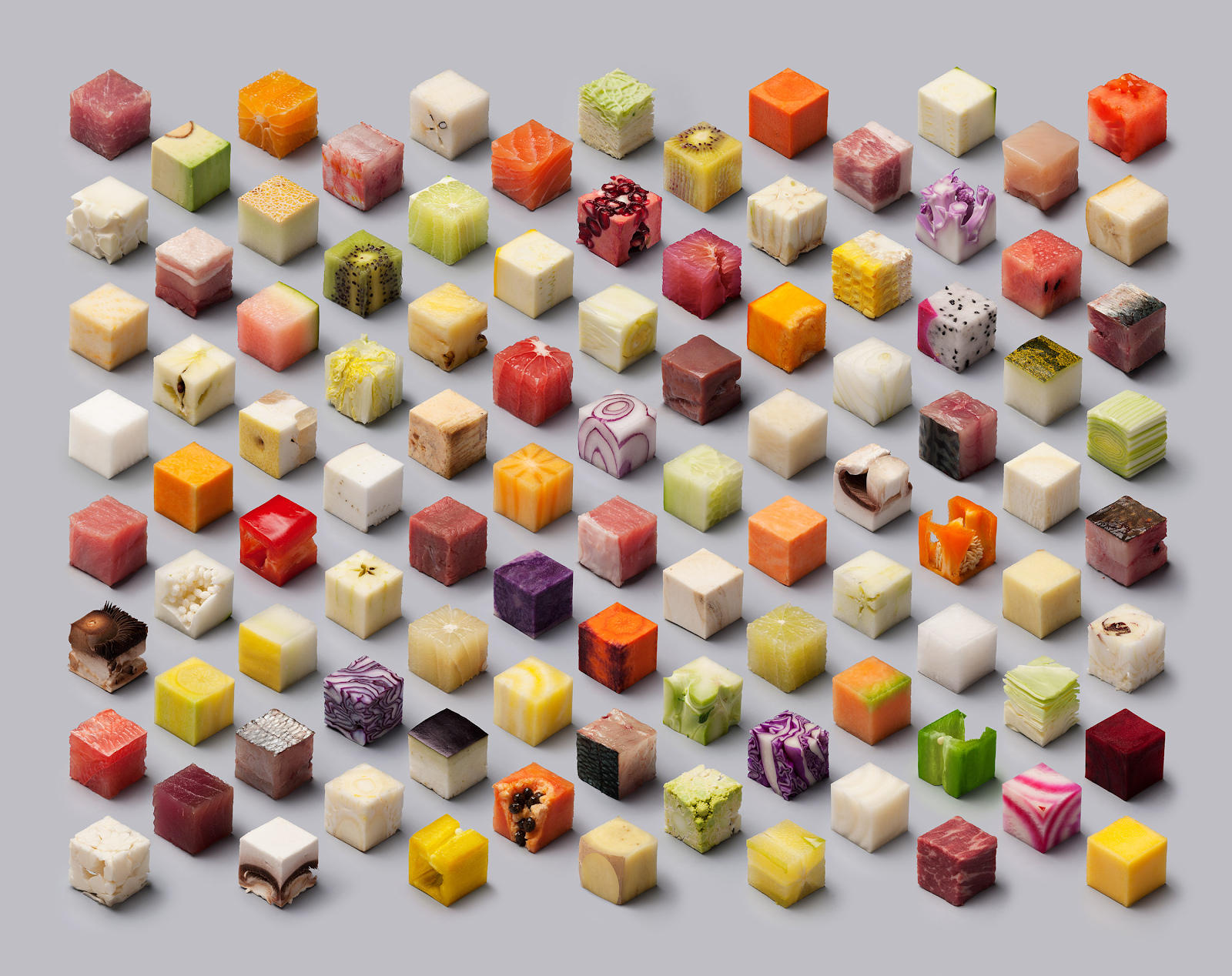Back in 2015, Studio Lernert & Sander cut 98 different foods into identical cubes and arranged them in perfect rows. The photo, entitled “Cubes,” immediately went viral on social media. Independent writer Christopher Hooton called it “a minimalist’s dream.” Everything was so fresh and gleaming and colorful. It looked like an appetizer business people would eat on a spaceship.
I spotted an orange, a bell pepper, a tuna. It was surprisingly difficult to figure out what each food was, now that they were no longer in their natural forms. The more I stared the more I felt uneasy. The kernels on the corn weren’t allowed to curve out. Instead, they were sliced straight through. The orange, similarly, ended mid-pulp rather than at the rind.
I wasn’t at all used to seeing food this way, and maybe that was the point. “We realized that if you cut up everything, it has this nastiness of everything becoming processed,” Lerner Engelberts said to Bon Appétit.
In the age of Instagram foodies and the Museum of Ice Cream, we process food with filters and the proper lighting. Our food is neon and shiny and supposedly delicious. In this way, it’s also often more visual than edible. Maybe that’s why food has been gaining traction as an artistic medium.
Like “Cubes,” Jen Monroe’s art features food that doesn’t look quite like food. Her meals are monochromatic, so carefully curated that they’ve become beautiful and alien. Green grapes sit next to an unripe starfruit, cauliflower stems and amorphous jellies. We’re in some alternate reality. Sometimes fruit rinds cradle jellies, as if hatching them. Sometimes the jellies are in oysters with purple beads, all on a purple patch of fur.
She takes the tendency to turn food into aesthetic objects to an extreme. Her art is appetizing in a way that confuses me. I don’t want to eat the food, but then I do. I realize that I like the concept of a wheatgrass shot — and its association to wellness culture — a lot more than I like the taste.
Monroe’s work also reminds me of sterile forms we dream up for food in the future. We already live in a world with Soylent and 3-D printed food and lab-grown meat. They eat beige mush in “The Matrix.” Food synthesizers in “Star Trek” make ice cream sundaes out of thin air. Food is a connecting thread in sci-fi movies, the smallest bit of familiarity transporting audiences to different realities. No matter what, in hundreds of years, we will probably still be eating.
It’s interesting to see the interplay between food’s practical purpose and aesthetics, and how we attach value to both. Beautiful food is expensive and healthy food is expensive. It’s an immense privilege to be able to play with food and make art, rather than view it as a necessity for survival.
This is especially pressing amidst rising wealth inequality and climate change, which disproportionately affects vulnerable communities. “How can we continue to invent pleasure for ourselves in a world of scarcity, and what can envisioning that future do to change our current relationship to food, or to the world?” Monroe asked in an interview with The Creative Independent.
She set up “The Next Menu,” a dinner party that imagined seafood in a future 30 years from now where we haven’t ramped up our efforts to address climate change. Guests sat and ate meals with seaweed and anchovies and jelly. They were presented ever-so-slightly removed from what’s familiar — diced in salad and carefully baked into tarts. They drank cocktails with microalgae frozen in the ice cubes. Microalgae, a presenter explained, evolves quickly and is more resilient to climate change.
Maybe this was yet another chance for people to post photos of their dessert on social media. Maybe it also pushed them to interrogate what they expect from food, and consider how scarce it is. Processed food, though labeled “nasty,” lasts longer. I wonder if the “Cubes”’s photographers ate the pieces or threw them away.
Contact Emily Zhang at ezhang3 ‘at’ stanford.edu.
